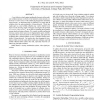Free Online Productivity Tools
i2Speak
i2Symbol
i2OCR
iTex2Img
iWeb2Print
iWeb2Shot
i2Type
iPdf2Split
iPdf2Merge
i2Bopomofo
i2Arabic
i2Style
i2Image
i2PDF
iLatex2Rtf
Sci2ools
ICIP
2006
IEEE
2006
IEEE
Behavior Forensics in Traitors within Traitors for Scalable Multimedia
A cost effective attack against multimedia forensics is the multiuser collusion attack, in which several attackers mount attacks collectively to remove traces of the identifying fingerprints and hinder traitor tracing. An important issue in collusion is to ensure that all colluders have the same probability of being detected. While they might agree so, some selfish colluders may wish to further lower their own risk of being caught. This paper investigates this problem of "traitors within traitors", in an effort to formulate the dynamics among attackers during collusion. We consider scalable multimedia forensic systems where users receive fingerprinted copies of different quality due to network and device heterogeneity, and explore the techniques that a selfish colluder can use to minimize his/her probability of being detected. Our results show that changing the resolution of their received copies before multi-user collusion can help selfish colluders further reduce their ris...
Attackers Mount Attacks | Cost Effective Attack | ICIP 2006 | Image Processing | Multi-user Collusion | Multiuser Collusion Attack | Selfish Colluders |
| Added | 22 Oct 2009 |
| Updated | 22 Oct 2009 |
| Type | Conference |
| Year | 2006 |
| Where | ICIP |
| Authors | K. J. Ray Liu, H. Vicky Zhao |
Comments (0)

